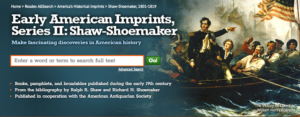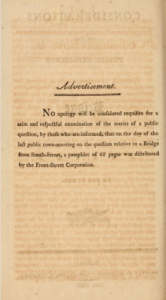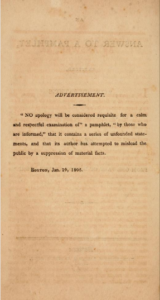Guest contributor Adam Fales grew up in Kansas and recently graduated from Fordham University. He is currently an AAS digital scholarship intern sponsored by the English Department at New York University and is a manager at Book Culture in New York City.
“And, indeed, if there is a counterpart to the confusion of a library, it is the order of its catalogue. Thus there is in the life of a collector a dialectical tension between the poles of disorder and order.”
Walter Benjamin, “Unpacking My Library”
Working in an independent bookstore and pursuing archival research as an undergrad, I had a set idea of what a collection of books looked like. In my earliest research experiences, I idealized the elegant Rose Reading Room at the New York Public Library. As a freshman, I wondered with a professor at the generations of scholars and writers who had worked in that same room. He asked me, “Can you imagine?”
I’ve spent my time since then trying to do so.
Even with the ongoing digitization of archives, we conjure a similarly majestic place in our minds. The home page of Readex’s Early American Imprints adorns its search function with famous paintings of American historical subjects, like William Henry Powell’s The Victory on Lake Erie.

Log in enough times, and the images cycle through other subjects, but their message remains the same: this archive exists alongside history’s grandest events. Commodore Oliver Hazard Perry points his ship towards victory (and the American flag), just as Readex’s archive will point us toward a victorious understanding of the past (and primary documents).
Actual archival research is less grandiose (and, often, less victorious). This past summer, I’ve worked as a digital research intern for AAS. I worked with some of the North American Imprints Program’s bibliographic metadata, matching various catalog records. In my work, an archive looks quite different from a reading room or an historical painting; it looks like a spreadsheet.

Rather than, say, see all the books printed in New York between 1801 and 1804 and then break those books down by subject, I proceeded more slowly through each year, examining the metadata of books, one by one. In the process, I got a portrait of Early American printing in the United States, as it unfolded in time, following narratives that I might have missed otherwise. For example, I was able to chart the development of scientific and medical knowledge through a series of
Inaugural Dissertations. These books, printed by colleges like Columbia to promote the research of newly minted doctors of physic and medicine, charted the accumulation of early nineteenth-century medical knowledge, as scholars researched yellow fever, lumbar abscess, and pulmonary consumption.
While a catalog search for “inaugural dissertation” might yield the same understanding of this scholastic development, my progress through these books, year-by-year and city-by-city told this story in a manner similar to how people would have lived it (albeit at an accelerated rate, as I proceeded through twenty years of books in one summer). In this way, I appreciated the developing use of purple foxglove in medicines, as doctors’ understanding developed from Jacob V. Brower’s Inaugural Dissertation (New York, 1802) to Lewis Burwell’s Observations (Philadelphia, 1805) to Thomas Edward Steell’s subsequent Inaugural Dissertation (New York, 1811). As I proceeded through each record in my spreadsheet, I appreciated the accumulation of knowledge on certain subjects, as a reader following a field might.
In some cases, this process brought me knowledge that scholars have already reached, but in a different way. For example, the prominence and republication of Isaac Watts’s collections of hymns and songs have been the object of much scholarly attention (such as recent Past is Present podcast guest Chris Phillips). Working with the metadata instead, I felt the sheer number of editions of works by Watts, as I worked with each record individually. This process yielded both appreciation and exasperation, as I grappled with the proliferating editions of each work. Experiencing the archive through metadata, I also felt amusement, such as with my discovery that William Tudor’s Considerations on the Public Expediency of a Bridge from One Part of Boston to the Other was met with An Answer to a Pamphlet, Entitled, “Considerations on the Public Expediency of a Bridge from One Part of Boston to the Other.” When I happened upon the latter some time after working with Tudor’s original pamphlet, I appreciated the biting parody, as Tudor’s detractor not only mimicked his title but also aped his opening “Advertisement.”


Again, this knowledge could be gained through more standard catalog searches and archival research, but my plodding through the metadata afforded a feeling of serendipity that I don’t think could be replicated. It brought me these works in a similarly disorganized manner to how readers find books. The pang of surprise increased my appreciation of the variety of works available to Early American readers, in a way that oddly resembles my day job as a bookseller in the twenty-first century. The appreciation, surprise, and exasperation that I feel shelving books and perusing publishers’ catalogs parallels how I feel sifting through metadata and identifying catalog records.
While the sanitized spreadsheet loses much of the sense experience of a used bookstore, with its musty smells and precariously stacked books, the two share an odd number of similarities. This results from the way metadata structures both spaces, determining how we organize archives and shop for books. Whether in the nineteenth or twenty-first century (or earlier), metadata has always been there. Place of publication, title, and author are integral parts of books, but now, in the age of spreadsheets, these parts have become hyper-visible. Reading for metadata will hardly replace the knowledge afforded by archival research, but it provides some narratives and sensations that might be missed otherwise. An archive does not just look like its metadata, but it would certainly look (and feel) differently without it.

One thought on “Unpacking a Digital Library: A Tour through Early American Metadata”